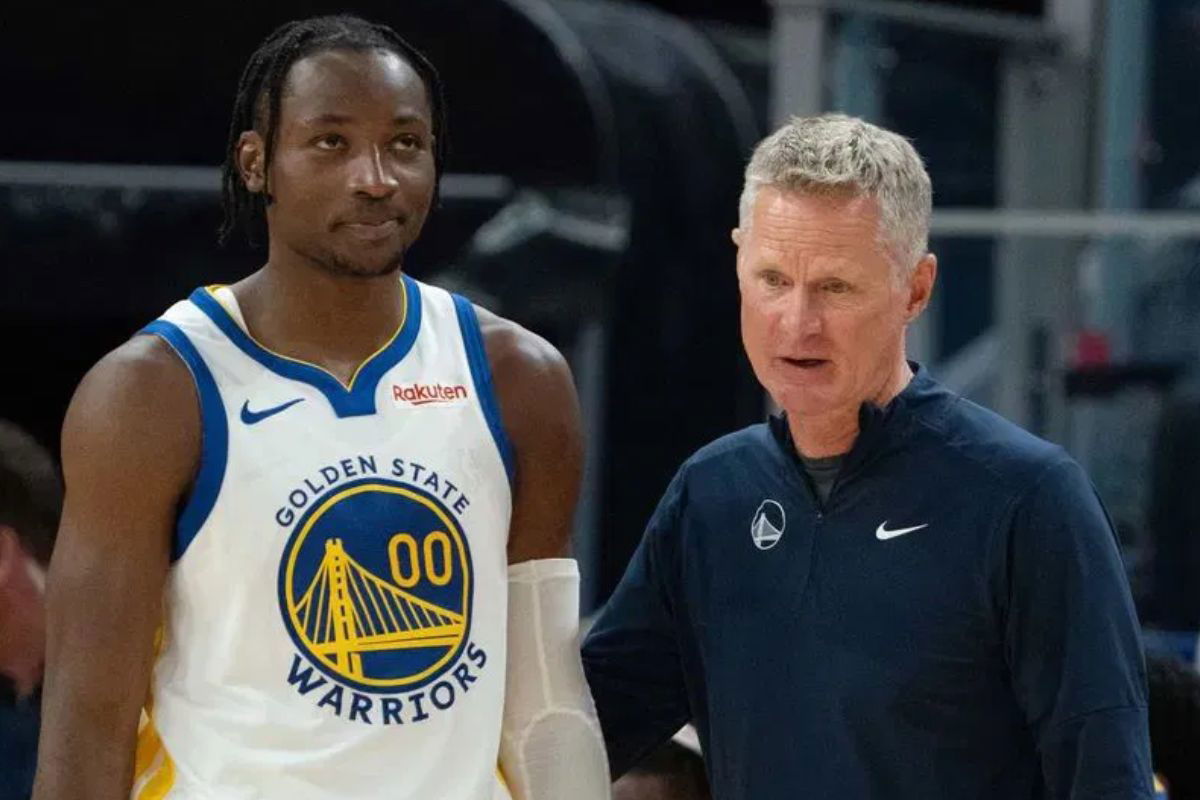
USA Today via Reuters
October 20, 2023; San Francisco, California, USA; Golden State Warriors head coach Steve Kerr (right) talks to forward Jonathan Kuminga (00) during the third quarter against the San Antonio Spurs at Chase Center. Mandatory Credit: Kyle Terada-USA TODAY Sports

USA Today via Reuters
October 20, 2023; San Francisco, California, USA; Golden State Warriors head coach Steve Kerr (right) talks to forward Jonathan Kuminga (00) during the third quarter against the San Antonio Spurs at Chase Center. Mandatory Credit: Kyle Terada-USA TODAY Sports
Offers, counteroffers, and months of back-and-forth ultimately left the Golden State Warriors and Jonathan Kuminga at a stalemate. With the October 1 deadline looming for his $7.9 million qualifying offer, both sides pivoted to a new path. The result: a two-year, $48.5 million extension beginning in the 2025–26 season.
Watch What’s Trending Now!
The deal, though, came with a compromise. Kuminga and his camp had pushed all summer for a player option, a safeguard that would give the 22-year-old control over his future. Instead, Golden State held firm, securing a team option instead.
ADVERTISEMENT
What Is a Team Option in NBA Contracts?
According to the NBA’s website, it makes a team eligible to maintain a player on its roster for another year. Meaning, the team has the cards and has control over the player’s future. If a player commits to a 2+1-year kind of deal, the 1 being the team option, this can play out in two ways. In the third year, the franchise can exercise the right and extend the contract. But if they don’t, then the player’s contract ends at that point, and the player becomes a Free Agent.
Now, reverse the roles, we have the Player Option clause. Instead of the team, it gives a player the option to accept or decline a contract already agreed upon for the following season. If the player refuses to exercise this option (therefore opting out), the player becomes an unrestricted free agent.
ADVERTISEMENT
How Does a Team Option Work in Rookie Contracts?
Team options function similarly in rookie and veteran contracts, with one key difference. Standard veteran contracts can include only one team option year. However, rookie-scale contracts for first-round NBA draft picks include team options for both the third and fourth years, creating a standard four-year structure with the first two years fully guaranteed.
For example, this results in a two-year guaranteed contract followed by two team option years, providing first-round rookies with greater financial stability at the start of their professional careers.
ADVERTISEMENT
Jonathan Kuminga’s Contract Situation Explained
Coming back to the Warriors forward, he was their 1st round overall 7th pick in 2021. Meaning, the team always liked the 22-year-old and his potential. On Aug 03, 2021, the Congolese native signed a four-year regular rookie scale contract totaling $24.9 million with Golden State. The first two seasons were guaranteed, and the next were options. In the next two seasons, the Warriors exercised their team option to lock in the player for the future. That brings us to this year, where there was a lot of drama.

Imago
October 30, 2021; San Francisco, California, USA; Golden State Warriors forward Jonathan Kuminga (00) listens to forward Draymond Green (23) during the fourth quarter against the Oklahoma City Thunder at Chase Center. Mandatory Credit: Kyle Terada-Imagn Images
The Dub Nation made multiple efforts to secure the future of Jonathan Kuminga. Previously, they offered two years and $45 million with a team option, and earlier this month, they raised it to a three-year, $75 million contract with a team option.
ADVERTISEMENT
The players’ agents had pushed for a player option, seeking maximum control over future earnings. Instead, the team option grants Golden State the ability to revisit financial commitments next year, a subtle but meaningful lever in the team’s broader luxury tax and roster strategy.
Kuminga’s case shows how valuable team options are for franchises and how tricky they can be for players.
ADVERTISEMENT
Is Jonathan Kuminga’s Sacrifice in the Contract Related to the Team Option?
Yes, his situation is closely tied to the power team options given to franchises. The agreement itself, a two-year, $48.5 million deal with a team option, resolves the immediate standoff but leaves open questions about long-term planning. ESPN’s Shams Charania added that the second year of the deal has a team option that is “designed for the contract to be ripped up” and allow Kuminga to jump into free agency.
Plus, this allows the Warriors to trade Jonathan Kuminga mid-season, starting January 15. Several league insiders told ESPN and Associated Press that Kuminga’s contract is “team-friendly” compared to his upside. Similarly, Bobby Marks of ESPN noted the structure — with a team option in year two — gives Golden State flexibility while leaving Kuminga exposed if he outplays the contract. “If he has a breakout season, he could find himself locked into below-market pay for 2026.”
Other NBA Players Who Dealt With Team Options
Just this summer, apart from Jonathan Kuminga, we had three other players who had their contract issues dangling over their heads. Cam Thomas, Josh Giddey, and Quentin Grimes. Interestingly, all three players had different resolutions in the offseason. Cam Thomas signed a one-year, $6 million qualifying offer to return to the Brooklyn Nets. On the other hand, Josh Giddey got paid handsomely as he negotiated a four-year, $100 million deal with the Bulls.
Until now, Philadelphia’s Quentin Grimes remains a restricted free agent. This clearly signified that some accepted long-term security, while others gambled on shorter deals for more control.
ADVERTISEMENT
ADVERTISEMENT
ADVERTISEMENT

